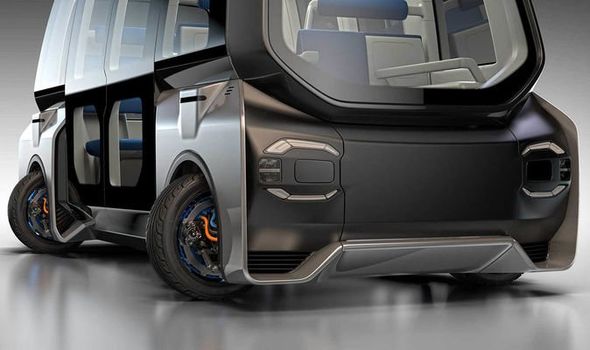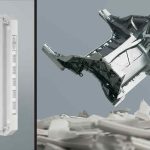
SLOW SPEED – REAR STEER MODE
At slow speeds, the rear wheels turn in the direction opposite to the front wheels. This mode comes in particularly useful in case of pickup trucks and buses, more so when navigating hilly regions. It can reduce the turning circle radius by 25%, and can be equally effective in congested city conditions, where U-turns and tight streets are made easier to navigate.
HIGH SPEED
In high speeds, turning the rear wheels through an angle opposite to front wheels might lead to vehicle instability and is thus unsuitable. Hence, at speeds above 80 kmph, the rear wheels are turned in the same direction of front wheels in four-wheel steering systems.
For a typical vehicle, the vehicle speed determining the change of phase has been found to be 80 km/hr. The steering ratio, however, can be changed depending on the effectiveness of the rear steering mechanism and can be as high as 1:1.
ZERO TURNING CIRCLE RADIUS – 360 DEGREE MODE
In addition to the afore mentioned steering types, a new type of four-wheel steering was introduced by the concept vehicle Jeep Hurricane, one that could significantly affect the way our vehicles are parked in the future.
This vehicle has all the three modes of steering described above, though it sports a truly complex drive-train and steering layout with two transfer cases to drive the left and right wheels separately. The four wheels have fully independent steering and need to turn in an unconventional direction to ensure that the vehicle turns around on its own axis.
WORKING PRINCIPLE OF ZERO TURN MECHANISM
Such a system requires precise calculation from a servo motor with real-time feedback to make certain that all three steering modes function perfectly. The concept didn’t make it to production, possibly due to the high costs involved in the power-train layout. But the idea presented by the concept continues to find importance. The only major problem posed by this layout is that conventional rack-and-pinion steering with pitman’s arms would not be suitable for this mode since the two front wheels are steered in opposite directions. Steer-by-wire systems would work fine, however, since independent control can be achieved.
When making a movement other than straight ahead driving. These forces compete with each other during steering maneuvers. With a front-steered vehicle, the rear end is always trying to catch up to the directional changes of the front wheels. This causes the vehicle to sway. When turning, the driver is putting into motion a complex series of forces. Each of these must be balanced against the others. The tires are subjected to road grip and slip angle. Grip holds the car’s wheels to he road, and momentum moves the car straight ahead. Steering input causes the front wheels to turn.
APPLICATIONS OF 360 DEGREE TURNING VEHICLE
- Parallel parking
- Zero steer can significantly ease the parking process due to its extremely short turning footprint. This is exemplified by the parallel parking scenario which is common in foreign countries and is pretty relevant to our cities. Here a car has to park itself between the two other cars parked on the service lane.
- High-speed lane changing
- Another driving manoeuvre that frequently becomes cumbersome and even dangerous is changing lanes at fairly high speed. Although this is less steering sensitive this does require a lot of concentration from the driver since he has to judge the space and vehicles behind them. The vehicle with arrows is the model under study. As can be seen from the figure the vehicle can turn with hardly any space requirement with a single steering action and also resume without any corrective inputs. Thus it also acts as a driver aid helping relatively inexperienced drivers make quick lane changes even at high speeds.
- The manufactured the first four-wheel steering car and it defines four-wheel steering as the effect of the 4WS mechanism acting in this way was non-linear steering.
ADVANTAGES OF ZERO TURN MECHANISM
- It reduces the turning radius.
- Such simple that an unskilled driver.
- Very useful in the heavy traffic of metro cities.
- Parking of the car in less space is made very simple.
DISADVANTAGES OF ZERO RADIUS TURNING VEHICLE
- Initial cost is high.
- It increases the crabbing effect while driving.

